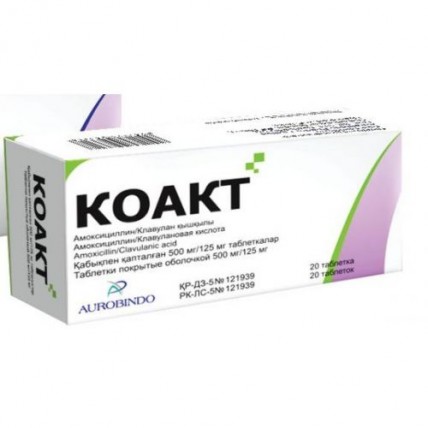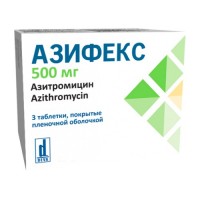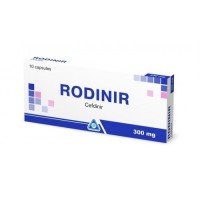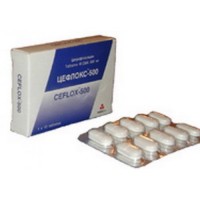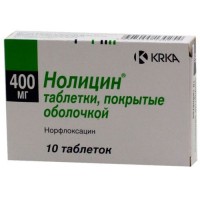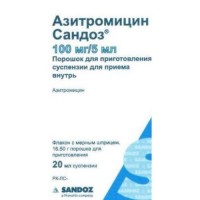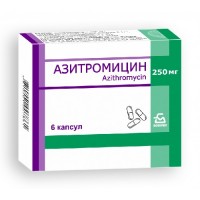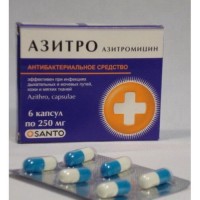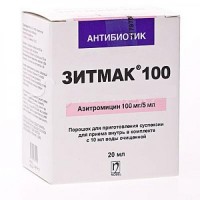Koakt 500 mg / 125 mg film-coated (20 tablets)
- $12.90
Sku:
09bcacc05a36
The instruction for medical use of KOAKT medicine Trade name Koakt the International unlicensed name Is not present the Dosage form of the Tablet, coated 250 mg / 125 mg, 500 mg / 125 mg, 875 mg / 125 mg Structure One tablet contains active agents: amoxicillin of trihydrate of 286.70 mg (it is equivalent to amoxicillin of 250.00 mg of potassium of clavulanate + Avitsel (1: 1) 277.77 to mg (it is equivalent to clavulanic acid of 125.00 mg) amoxicillin of trihydrate of 573.40 mg (it is equivalent to amoxicillin of 500.00 mg of potassium of clavulanate + Avitsel (1: 1) 277.77 to mg (it is equivalent to clavulanic acid of 125.00 mg) amoxicillin of trihydrate of 1003.44 mg (it is equivalent to amoxicillin of 875.00 mg of potassium of clavulanate + Avitsel (1: 1) 277.77 to mg (it is equivalent to clavulanic acid of 125.00 mg) excipients: cellulose microcrystalline (PH 101), sodium of starch glikolit (type A), silicon dioxide colloidal anhydrous, magnesium stearate, structure of a cover: Opadri white 06B58855 IHS (a gipromelloza 5 sr (E464), the titan dioxide (E171), makrogol/PEG 400, a gipromelloza 15 sr (E464)) the Description of the Tablet of an oval form, coated white color, with an engraving 'And' on one party and with an engraving '63' on other party (for a dosage of 250 mg / 125 mg) Tablets of an oval form, coated white color, with an engraving 'And' on one party and with an engraving '64' on other party (for a dosage of 500 mg / 125 mg) Tablets of an oval form, coated white color, with an engraving 'And' on one party and with an engraving and risky between '6' and '5' on other party (for a dosage of 875 mg / 125 mg) Pharmacotherapeutic group Antibacterial drugs for system use. Beta laktamnye antibacterial drugs – Penicillin. Penicillin in a combination with inhibitors beta laktamaz. Clavulanic acid + amoxicillin. The ATX J01CR02 code the Pharmacological Pharmacokinetics Key Pharmacokinetic Parameters properties of amoxicillin and clavulanic acid are similar. Amoxicillin and clavulanic acid in a combination do not influence at each other. Absorption Amoxicillin and clavulanate are well dissolved in aqueous solutions with physiological value rn, quickly and completely soaked up from digestive tract after oral administration. Absorption of amoxicillin and clavulanic acid is optimum in case of administration of drug at the beginning of food. After administration of drug in its bioavailability makes 70%. Profiles of both components of drug are similar and reach peak concentration in plasma (Tmax) approximately in 1 hour. Concentration of amoxicillin and clavulanic acid in blood serum is identical as in case of combined use of amoxicillin and clavulanic acid, and each component separately. Distribution Therapeutic concentration of amoxicillin and clavulanic acid are reached in different bodies and fabrics, interstitial liquid (lungs, abdominal organs, the gall bladder, fat, bone and muscular fabrics, pleural, synovial and peritoneal liquids, skin, bile purulent separated to a phlegm). Amoxicillin and clavulanic acid practically do not get into cerebrospinal fluid. Linking of amoxicillin and clavulanic acid with proteins of plasma moderate: 25% for clavulanic acid and 18% for amoxicillin. Amoxicillin, as well as the majority of penicillin, is emitted with breast milk. In breast milk trace amounts of clavulanic acid are also found. Except for risk of a sensitization, amoxicillin and clavulanic acid has no negative impact on health of the babies raised by breast milk. Amoxicillin and clavulanic acid get through a placental barrier. Elimination Amoxicillin is removed, mainly by kidneys whereas clavulanic acid - by means of both renal, and extrarenal mechanisms. After single dose in one tablet of 250 mg / 125 mg or 500 mg / 125 the mg about 60-70% of amoxicillin and 40-65% of clavulanic acid during the first 6 h is removed with urine in not changed look. Metabolism Amoxicillin is partially allocated with urine in the form of inactive penicillic acid in the quantity equivalent to 10-25% of the accepted dose. Clavulanic acid in an organism is exposed to intensive metabolism to 2.5-digidro-4-(2 hydroxyethyl) - 5-oxo-1H-pyrrol-3-carboxylic acid and 1 - amino - 4 - hydroxy - butane - 2 - it also is allocated with urine and a stake and also in the form of carbon dioxide through expired air. Pharmacodynamics Koakt an antibiotic of a broad spectrum of activity, contains semi-synthetic penicillin amoxicillin and inhibitor beta laktamaz clavulanic acid. Clavulanic acid inhibits the majority clinically significant beta laktamaz, the produced Staphylococcus spp., Escherichia coli, Proteus mirabilis, Haemophilus influenzae, Moraxella catarrhalis, Bacteroides spp. It is inactive concerning a beta laktamaz of 1 type produced by Enterobacter spp., Morganella morganii, Pseudomonas aeruginosa, Serratia spp., Acinetobacter spp. Koakt is the combined antibiotic containing amoxicillin and clavulanic acid with a wide range of bactericidal action, resistant to a beta laktamaze. Amoxicillin is the semi-synthetic antibiotic of a broad spectrum of activity active concerning many gram-positive and gram-negative microorganisms. Amoxicillin collapses under the influence of a beta laktamaz and does not affect microorganisms which produce this enzyme. The mechanism of effect of amoxicillin consists in inhibition of biosynthesis of peptidoglikan of a cell wall of a bacterium that usually leads to lysis and death of a cell. Clavulanic acid is beta laktamat, on chemical structure close to penicillin which has ability to inactivate enzymes beta laktamaz the microorganisms showing to rezistentnosit to penicillin and cephalosporins, thereby preventing an amoxicillin inactivation. Beta laktamazy are produced by many gram-positive and gram-negative bacteria. Action beta laktamaz can lead to destruction of some antibacterial drugs even prior to their impact on pathogens. Clavulanic acid blocks effect of enzymes, restoring sensitivity of bacteria to amoxicillin. In particular, it has high activity concerning plasmid beta laktamaz with which the medicinal resistance is often connected, but is less effective concerning chromosomal beta laktamaz 1 type. Presence of clavulanic acid as a part of KOAKTa protects amoxicillin from the destroying action beta laktamaz and expands its range of antibacterial activity with inclusion in it of the microorganisms usually resistant to other penicillin and cephalosporins. Clavulanic acid in the form of monodrug does not render clinically significant antibacterial effect. Koakt has bactericidal effect on the following microorganisms: Gram-positive aerobes: Enterococcus faecalis, Gardnerella vaginalis, Staphylococcus aureus (sensitive to Methicillinum), a coagualase - negative staphylococcus (sensitive to Methicillinum), Streptococcus agalactiae, Streptococcus pneumoniae1, Streptococcus pyogenes and other beta and hemolytic streptococci, the group Streptococcus viridans, Bacillius anthracis, Listeria monocytogenes, Nocardia asteroides Gram-negative aerobes: Actinobacillus actinomycetemcomitans, Capnocytophaga spp., Eikenella corrodens, Haemophilus influenzae, Moraxella catarrhalis, Neisseria gonorrhoeae, Pasteurella multocida anaerobic microorganisms: Bacteroides fragilis, Fusobacterium nucleatum, Prevotella spp. Microorganisms with the possible acquired resistance Gram-positive aerobes: Enterococcus faecium * Gram-negative aerobes: Escherichia coli, Klebsiella oxytoca, Klebsiella pneumoniae, Proteus mirabilis, Proteus vulgaris Microorganisms with natural resistance: gram-negative aerobes: Acinetobacter species, Citrobacter freundii, Enterobacter species, Legionella pneumophila, Morganella morganii, Providencia species, Pseudomonas species, Serratia species, Stenotrophomonas maltophilia, other: Chlamydia trachomatis, Chlamydophila pneumoniae, Chlamydophila psittaci, Coxiella burnetti, Mycoplasma pneumoniae. * Natural sensitivity in the absence of the acquired resistance 1 except for strains of Streptococcus pneumoniae resistant to penicillin Indications the Infectious and inflammatory diseases caused by microorganisms, sensitive to drug: - an infection of upper parts of airways (including sinusitis, tonsillitis, average otitis) - infections of lower parts of airways (including acute and chronic bronchitis, pneumonia) - infections of urinary tract (cystitis, an urethritis, pyelonephritis) - infections of skin and soft tissues (including, number stings of animals, abscess and phlegmons of maxillofacial area) - intraabdominal infections (septic abortion, patrimonial sepsis, intraabdominal sepsis) - infections of bones and joints (including, osteomyelitis) the Route of administration and doses the Mode of dosing is set individually depending on age, body weight, function of kidneys and also from severity of an infection. Before prescribing of drug it is whenever possible necessary to estimate sensitivity of strains according to local data and to define sensitivity by a fence and the analysis of samples at the specific patient, especially in case of heavy infections. Koakt it can be applied to treatment of the infections caused amoxicillin - sensitive microorganisms, and the multi-infections caused amoxicillin - and clavulanate - the sensitive strains producing beta lactamazu. As tablets Koakt on 375 mg, 625 mg and 1000 mg contain the same amount of clavulanic acid (125 mg in the form of potassium salt), two tablets Koakt on 375 mg are not equivalent to one tablet of Ko Amoxiclav on 625 mg therefore, it is impossible to replace with two tablets KOAKT on 375 mg one tablet Koakt on 625 mg. For decrease in potential risk of influence on digestive tract, Koakt it is recommended to accept together with food, at the beginning of food for its maximum absorption. A usual adult dose - one tablet of 625 mg Koakt of each 12 hours or one tablet of 375 mg Koakt of each 8 hours. In heavier infections and respiratory infections, the dose has to make one tablet of 1000 mg KOAKT of each 12 hours or one tablet of 625 mg Koakt of each 8 hours. Time of the carried-out therapy depends on the response of the patient to the carried-out treatment. Some pathologies (in particular, osteomyelitis) can demand longer course. It is not necessary to continue treatment more than 14 days without repeated assessment of a condition of the patient. If necessary performing step therapy is possible (intravenous administration of drug with the subsequent transition to oral administration in the beginning). Adults and children are more senior than 12 years or with body weight more than 40 kg the Easy and medium-weight course of an infection (standard dose) 1 tablet of 500 mg / 125 mg 2-3 times a day or 1 tablet of 875 mg / 125 mg 2 times a day Heavy infections (a lower respiratory tract infection, an infection of an urinogenital path) 1-2 tablet of 500 mg / 125 mg 3 times a day or 1 tablet of 875 mg / 125 mg 2 or 3 times a day the Maximum daily dose for adults and children is more senior than 12 years applying tablets a dosage of 500 mg / 125 mg, makes 1500 mg of amoxicillin / 375 clavulanic acid mg. For tablets a dosage of 875 mg / 125 to mg the maximum daily dose is equal to 1750 mg of amoxicillin / 250 to clavulanic acid mg (at reception 2 times a day) or 2625 mg of amoxicillin / 375 to clavulanic acid mg (at reception 3 times a day). Patients with renal failures the Correction of doses is based on the maximum recommended dose of amoxicillin and value of clearance of creatinine. - insignificant dysfunction (clearance of creatinine & gt, 30 ml/min.): the dose does not change. - moderate dysfunction (clearance of creatinine of 10-30 ml/min.): one tablet of 625 mg each 12 hours. - heavy dysfunction (clearance of creatinine & lt, 10 ml/min.): use is not recommended. Tablets with a dosage of 875 mg / 125 mg should be applied only at patients with clearance of creatinine & gt, 30 ml/min. The patients who are on a hemodialysis the Correction of doses is based on the maximum recommended amoxicillin dose. Adults: 1 tablet of 500 mg / 125 mg each 24 h. 1 dose is in addition appointed during the session of dialysis and one more dose at the end of dialysis session (for compensation of decrease in serumal concentration of amoxicillin and clavulanic acid). Patients with abnormal liver functions Drug should be used with care. It is necessary to check function of a liver regularly. Elderly patients it is not necessary to Reduce dose Koakta, doses same, as for adults. At elderly patients with renal failures the dose should be adjusted as it is stated above for adults with renal failures. The maximum daily dose of amoxicillin makes 6 g for the adult and 45 mg/kg of body weight for children. The maximum daily dose of clavulanic acid (in the form of potassium salt) makes 600 mg for the adult and 10 mg/kg of body weight for children. An abnormal liver function Drug should be used with care. It is necessary to check function of a liver regularly. In the infections caused by β-hemolytic streptococci for the purpose of prevention of development of late complications (e.g., rheumatic fever, a glomerulonephritis), the therapy lasting not less than 10 days is shown. Side effects Very often ≥ 1 of 10, is frequent ≥ 1 of 100 and & lt, 1 of 10, sometimes ≥ 1 of 1000 and & lt, 1 of 100, is rare ≥ 1 of 10000 and & lt, 1 of 1.000, also lt is very rare, 1 of 10000 is frequent - candidiasis of skin and mucous covers - nausea, vomiting, diarrhea Nausea meets at use of high doses of drug more often. For decrease in extent of manifestation it is recommended to accept suspension at the beginning of meal. Infrequently - dizziness, a headache - dyspepsia - moderate increase in level of liver enzymes of ALT/nuclear heating plant - skin rash, an itching, a small tortoiseshell Seldom - a reversible leukopenia (including a neutropenia), thrombocytopenia - a multiformny erythema Is unknown - a reversible agranulocytosis and hemolytic anemia, increase in a bleeding time and the index of a prothrombin time - a Quincke's disease, an anaphylaxis, the syndrome similar to a serum disease, an allergic vasculitis - reversible superactivity and spasms - the antibiotiko-associated colitis (including pseudomembranous and hemorrhagic) - black hairy language (chronic hyperplasia of threadlike nipples of language) - hepatitis, cholestatic jaundice - Stephens-Johnson's syndrome, a toxic epidermal necrolysis, bullous exfoliative dermatitis, sharp generalized exanthematous pustulyoz. At development of these symptoms, drug has to be cancelled. - interstitial nephrite, the Contraindication crystalluria - hypersensitivity to penicillin or to any component of drug - the known hypersensitivity to others beta laktamnym to antibiotics (cephalosporins, karbapenema, monobaktama) - an infectious mononucleosis - a lymphoid leukosis - a liver failure - the cholestatic jaundice or hepatitis caused by reception of antibiotics of group of penicillin in the anamnesis - bronchial asthma, a senny pollinosis - children's age up to 12 years or children with body weight less than 40 kg Medicinal interactions At simultaneous use Koakta and indirect anticoagulants is noted increase in a prothrombin time. Therefore this combination is appointed with care. At simultaneous use Koakta with Allopyrinolum the risk of development of such side effects as a dieback increases. At simultaneous use Koakt enhances toxicity of a methotrexate. Antacids, a glycosamine, depletive, aminoglycosides slow down and reduce absorption Koakta, ascorbic acid increases it. Bactericidal antibiotics (including aminoglycosides, cephalosporins, Cycloserinum, Vancomycinum, rifampicin) have sinergidny effect, bacteriostatic drugs (macroleads, chloramphenicol, linkozamida, tetracyclines, streptocides) – antagonistic. At simultaneous use Koakt reduces efficiency of oral contraceptives. Probenetsid reduces renal canalicular secretion of amoxicillin. It is not recommended to apply Koakt along with probenitsidy. Simultaneous use with Koaktom can lead it to the increased amoxicillin level in blood, however, it is not observed concerning clavulanic acid.
some cases drug can extend a prothrombin time, for this reason it is necessary to be careful at simultaneous use of oral anticoagulants and Koakta. At the patients accepting mikofenolat mofetit, at combined use with Koaktom the concentration of an active metabolite of mikofenolovy acid when assigning an initial dose decreases approximately by 50%. Change of level of concentration of an initial dose can not correspond to changes of concentration of total exposure of mikofenolovy acid. Special instructions Before an initiation of treatment Koakt need to be collected the detailed anamnesis concerning the previous reactions of hypersensitivity to penicillin, cephalosporins or others beta laktamnye antibiotics. Also fatal reactions of hypersensitivity (acute anaphylaxis) on penicillin which came to light at patients with the previous hypersensitivity on penicillin more often are described serious, and sometimes. In case of allergic reaction it is necessary to stop treatment by Koakt and to begin alternative therapy. At development of serious reactions of hypersensitivity the patient should enter adrenaline immediately. Oxygenotherapy, the intravenous administration of steroids and ensuring passability of airways including an intubation can be required. Koakt it is not necessary to appoint at suspicion of an infectious mononucleosis as with this disease amoxicillin can cause skin rash in patients that complicates diagnosis of a disease. Long-term treatment by Koakt can be followed by the overgrowth of microorganisms, insensitive to it. Cases of development of pseudomembranous colitis against the background of use of antibiotics which weight varied from easy to heavy degree, life-threatening patients were revealed. Thus, it must be kept in mind possibility of this pathology at patients with diarrhea at reception of antibiotics or after the termination of a course of therapy. In case of development of long or considerable diarrhea, in the presence of spasms in a stomach, treatment by Koakt has to be immediately stopped and patients have to be directed to further inspection. In general, Koakt is transferred well and has hypotoxicity inherent to all penicillin. At long treatment by Koakt it is recommended to estimate periodically functions of kidneys, a liver, bodies of a hemopoiesis. At the patients receiving Koakt the increase in a prothrombin time therefore at simultaneous use of Koakt and anticoagulants it is necessary to carry out the corresponding monitoring with a possible dose decline of anticoagulant in case of need is occasionally observed. With care it is necessary to apply Koakt at patients with an abnormal liver function. Signs and symptoms of damage of a liver usually arise in time or right after an initiation of treatment, but in certain cases can not be shown within several weeks after the therapy termination. As a rule, they are reversible. Hepatic violations can be very serious, and in extremely exceptional cases was reported about death. Almost always they were registered at patients with a serious basic disease or at those who at the same time took the drugs known as potentially influencing a liver. At patients with a renal failure the dose of drug has to be adjusted according to disease severity. When prescribing drug to patients with reduced function of kidneys or when using high doses the development of spasms is possible. Patients with a reduced diuresis in rare instances can have a crystalluria. During introduction of high doses of amoxicillin it is recommended to accept enough liquid and to support an adequate diuresis for reduction of probability of formation of crystals of amoxicillin. At patients with a catheter constant assessment of their state is necessary. Combined use of Allopyrinolum and amoxicillin increases a likelihood of development of skin allergic reactions. During treatment by amoxicillin for determination of content of glucose in urine it is necessary to use methods of fermental oxidation of glucose as not fermental methods can lead to obtaining false positive results. Presence of clavulanic acid in Koakta can be the cause of nonspecific binding of IgG and albumine with a membrane of erythrocytes that leads to false positive reaction of Koombs. Pregnancy and the period of a lactation of KOAKT is not recommended to be applied during pregnancy. KOAKT gets into breast milk that can cause diarrhea and fungal infections of mucous membranes in the children who are on breastfeeding. The decision on use of drug during pregnancy and breastfeeding is accepted after careful assessment of a ratio of advantage and risk. When assigning in the period of a lactation it is recommended to stop breastfeeding. Features of influence of medicine on ability to run the vehicle or potentially dangerous mechanisms In extremely exceptional cases of KOAKT can cause such undesirable reactions as confusion of consciousness, dizziness and spasms which can break ability to run the vehicle and difficult mechanisms and/or it is safe to work. Overdose Symptoms: an abdominal pain, diarrhea, vomiting, it is possible also uneasiness, excitement, insomnia, dizziness, in some cases - spasms. Treatment: in case of recent administration of drug (less than 4 h) it is necessary to carry out gastric lavage and to appoint activated carbon for drug absorption reduction, if necessary carry out symptomatic therapy. The hemodialysis is effective. The form of release and packing On 5 tablets place in blister strip packagings from aluminum foil. On 4 blister strip packagings together with the instruction for medical use in the state and Russian languages place in a cardboard pack. To Store storage conditions in the dry, protected from light place at a temperature not above 30 °C. To store drug out of children's reach! 2 years not to use a period of storage after an expiration date! Prescription status According to the prescription Aurobindo Pharma Limited Producer, India the Owner of the registration certificate of Aurobindo Pharma Limited
to Develop the Address of the organization accepting claims from consumers on quality of products in the Republic of Kazakhstan of AVCARE LTD LLP Kazakhstan, Almaty, Ormanov St. 47/2
some cases drug can extend a prothrombin time, for this reason it is necessary to be careful at simultaneous use of oral anticoagulants and Koakta. At the patients accepting mikofenolat mofetit, at combined use with Koaktom the concentration of an active metabolite of mikofenolovy acid when assigning an initial dose decreases approximately by 50%. Change of level of concentration of an initial dose can not correspond to changes of concentration of total exposure of mikofenolovy acid. Special instructions Before an initiation of treatment Koakt need to be collected the detailed anamnesis concerning the previous reactions of hypersensitivity to penicillin, cephalosporins or others beta laktamnye antibiotics. Also fatal reactions of hypersensitivity (acute anaphylaxis) on penicillin which came to light at patients with the previous hypersensitivity on penicillin more often are described serious, and sometimes. In case of allergic reaction it is necessary to stop treatment by Koakt and to begin alternative therapy. At development of serious reactions of hypersensitivity the patient should enter adrenaline immediately. Oxygenotherapy, the intravenous administration of steroids and ensuring passability of airways including an intubation can be required. Koakt it is not necessary to appoint at suspicion of an infectious mononucleosis as with this disease amoxicillin can cause skin rash in patients that complicates diagnosis of a disease. Long-term treatment by Koakt can be followed by the overgrowth of microorganisms, insensitive to it. Cases of development of pseudomembranous colitis against the background of use of antibiotics which weight varied from easy to heavy degree, life-threatening patients were revealed. Thus, it must be kept in mind possibility of this pathology at patients with diarrhea at reception of antibiotics or after the termination of a course of therapy. In case of development of long or considerable diarrhea, in the presence of spasms in a stomach, treatment by Koakt has to be immediately stopped and patients have to be directed to further inspection. In general, Koakt is transferred well and has hypotoxicity inherent to all penicillin. At long treatment by Koakt it is recommended to estimate periodically functions of kidneys, a liver, bodies of a hemopoiesis. At the patients receiving Koakt the increase in a prothrombin time therefore at simultaneous use of Koakt and anticoagulants it is necessary to carry out the corresponding monitoring with a possible dose decline of anticoagulant in case of need is occasionally observed. With care it is necessary to apply Koakt at patients with an abnormal liver function. Signs and symptoms of damage of a liver usually arise in time or right after an initiation of treatment, but in certain cases can not be shown within several weeks after the therapy termination. As a rule, they are reversible. Hepatic violations can be very serious, and in extremely exceptional cases was reported about death. Almost always they were registered at patients with a serious basic disease or at those who at the same time took the drugs known as potentially influencing a liver. At patients with a renal failure the dose of drug has to be adjusted according to disease severity. When prescribing drug to patients with reduced function of kidneys or when using high doses the development of spasms is possible. Patients with a reduced diuresis in rare instances can have a crystalluria. During introduction of high doses of amoxicillin it is recommended to accept enough liquid and to support an adequate diuresis for reduction of probability of formation of crystals of amoxicillin. At patients with a catheter constant assessment of their state is necessary. Combined use of Allopyrinolum and amoxicillin increases a likelihood of development of skin allergic reactions. During treatment by amoxicillin for determination of content of glucose in urine it is necessary to use methods of fermental oxidation of glucose as not fermental methods can lead to obtaining false positive results. Presence of clavulanic acid in Koakta can be the cause of nonspecific binding of IgG and albumine with a membrane of erythrocytes that leads to false positive reaction of Koombs. Pregnancy and the period of a lactation of KOAKT is not recommended to be applied during pregnancy. KOAKT gets into breast milk that can cause diarrhea and fungal infections of mucous membranes in the children who are on breastfeeding. The decision on use of drug during pregnancy and breastfeeding is accepted after careful assessment of a ratio of advantage and risk. When assigning in the period of a lactation it is recommended to stop breastfeeding. Features of influence of medicine on ability to run the vehicle or potentially dangerous mechanisms In extremely exceptional cases of KOAKT can cause such undesirable reactions as confusion of consciousness, dizziness and spasms which can break ability to run the vehicle and difficult mechanisms and/or it is safe to work. Overdose Symptoms: an abdominal pain, diarrhea, vomiting, it is possible also uneasiness, excitement, insomnia, dizziness, in some cases - spasms. Treatment: in case of recent administration of drug (less than 4 h) it is necessary to carry out gastric lavage and to appoint activated carbon for drug absorption reduction, if necessary carry out symptomatic therapy. The hemodialysis is effective. The form of release and packing On 5 tablets place in blister strip packagings from aluminum foil. On 4 blister strip packagings together with the instruction for medical use in the state and Russian languages place in a cardboard pack. To Store storage conditions in the dry, protected from light place at a temperature not above 30 °C. To store drug out of children's reach! 2 years not to use a period of storage after an expiration date! Prescription status According to the prescription Aurobindo Pharma Limited Producer, India the Owner of the registration certificate of Aurobindo Pharma Limited
to Develop the Address of the organization accepting claims from consumers on quality of products in the Republic of Kazakhstan of AVCARE LTD LLP Kazakhstan, Almaty, Ormanov St. 47/2
